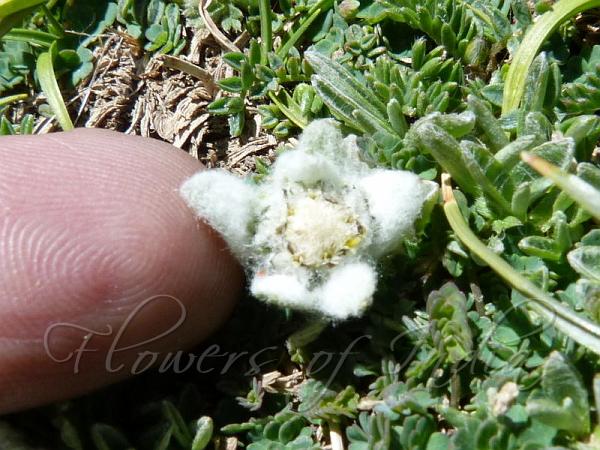|
| Tiny Edelweiss |
|

|

| File size | 145503 |
| Original date | 6/27/12 11:27 AM |
| Resolution | 800 x 600 |
| Flash | Flash did not fire, auto |
| Focal length | 4.5mm |
| Exposure time | 1/250s |
| Aperture | 5.6 |
| Focus Distance | |
| Metering Mode | Multi-segment |
| Camera make | Panasonic |
| Camera model | DMC-FZ40 |
| Sensor type | OneChipColorArea |
|
|
|
|
Photo: |
Botanical name: Leontopodium nanum Family: Asteraceae (Sunflower family)
Synonyms: Leontopodium alpinum var. nivale, Leontopodium jamesonii
Synonyms: Leontopodium alpinum var. nivale, Leontopodium jamesonii
Tiny Edelweiss is a stemless, densely tufted,
woolly, perennial herb, 3-7 cm high, densely covered with brown
scarious old leaf bases with rosettes of sterile leaves. Stolons are
usually present, up to 10 cm long, bearing scattered modified scarious
leaf blades. Leaves are spreading, linear lanceshaped,
inverted-lanceshaped or spoon-shaped, woolly on both surfaces, 1.25-2.5
x 0.2-0.5 cm. Flower-heads are solitary or 3-5, stalkless amongst the
leaves 7-13 mm in diameter predominantly female or male. Inflorescence
bracts not forming a star-like structure, similar to the other leaves
in size texture and indumentum. Phyllaries are 2-3 seriate, linear
lanceolate, 4-6 mm long, margin and the apex of the phyllaries dark
brown. Female florets filiform. Corolla c. 5 mm long, 4-lobed. Cypselas
brownish sparsely covered with minute hairs, about 1 mm long. Pappus
setae of the male florets thin, often totally barbellate; pappus of the
female not being barbellate or dilated at the tip, 8-9 mm long. Tiny
Edelweiss is found in Afghanistan, Pamir, Himalayas, Tibet, W China, at
altitudes of 2300-4900 m. Flowering: July-October.
| Identification credit: Tabish | Photographed in Nubra Valley, Ladakh. |